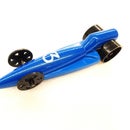Introduction: T-Tech Modular Guitar
Electric guitars come in many different shapes and designs. However, because they can be very expensive, people who want to buy an electric guitar have to chose a single design. We wanted a way to have a single guitar that can be interchangeable, in order to give the user different aesthetic options. We came up with the modular guitar which allows a user to have as many designs as he desires without the expense of an entirely new guitar. We used a 3D Modeling software called Solid Works and researched various parts in order to create our 3D Modeled guitar.
In order to make your own Modular Guitar, we have provided you with a comprehensive guide, detailing each step.
Step 1: Components Required
You will need these items in order to produce your Modular Guitar:
- Computer with Solid Works
- 3D Printer
- CNC
- Bandsaw
- Soldering Iron
- Router
- Drill
- Drill Press
- Wood
- Measuring Tools
- Default Guitar Parts
Step 2: Research Guitar Body Types
In order to embark on your journey to making your own Modular Guitar, you will first need to research various body types to find one that you most prefer.
There are many different websites that help show you all the information about each and every body type.
One that I recommend using is : https://ledgernote.com/columns/guitar-guru/types-o...
For our Modular Guitar, we chose the Gibson Les-Paul, and Flying V.
Step 3: Brainstorm and Sketch Ideas
Before starting to build anything, you will need to brainstorm and sketch out ideas on how your guitar bodies will be able to work together. Solutions include, magnets, dove tails, etc.
Figuring out measurements ahead of time, will help to reduce discrepancies later on.
Once you have gone through the Design Process, you will be able to move onto the next step.
Step 4: Model and Produce Center Core of Guitar Body
Before beginning to model the 3D Guitar bodies, you will first need to produce a center body piece for the parts to attach onto.
You will do this by creating a 3D model of a center core in SolidWorks. Dimension the center core to your liking and add the holes required to place the humbuckers, bridge, and headstock.
You will then send the files to a computer connected to the CNC Machine.
It will take some time for the CNC Machine to cutout the center core, so be patient.
After it has been cut out, take measurements and see if they are correct, if not, repeat this step until it has minimal errors.
Step 5: Begin Modeling Designs in SolidWorks
Test out the ideas you have drawn in your notebook. If it does not work, that is okay, this is the time to cross out the ideas that do not work.
Try to perfect the measurements, so when they are ready to be sent to the 3D printer, there will be little to no problems.
Find various solutions on how to attach the different pieces of the guitar body to the guitar center.
This step will be troublesome and time consuming, but as long as you perfect these designs, everything after will be easy to get through.
Step 6: 3D Print Designs
Send the files to your 3D Printer. 3D printing parts takes some time, so you can drink some coffee, or watch some T.V in the mean time.
After they are done printing out, the parts usually need to be sanded in order to be able to fit seamlessly. Try fitting the parts together to see if they fit, if not, take measurements, and find the problem.
If the measurements are too big or small, revert back to the previous step and fix the designs.
Step 7: Begin to Create and Assemble Headstock
You may begin this step only when you have made sure all previous measurements have been taken into account and have minimal errors.
Cut out a piece of wood that resembles a head stock. Make sure the dimensions go along with your center core slit. Cut out the holes on the head stock, and crevices for the usual guitar parts to insert into.
If you want the head stock to feel smooth to the touch, you may sand the head stock.
You may then begin placing the parts, such as the fret board, frets, truss rod, etc.
You may move on once you are comfortable with your head stock.
Step 8: Begin Wiring the Electronics
This process will take some trial and error.
You will need to solder together a string of electronics that will allow you to play the guitar using an amp.
Use instructions provided by the internet to help you on this step. It will tell you the necessary components required to utilize the electric aspect of the guitar properly.
Once you are done soldering the wires together, test the circuits with a guitar amp.
If it does not work, be patient, you will need to go through trial and error to perfect the circuit in order to create a pleasing sound.
Step 9: Time to Assemble All the Parts
Now that you have all the parts required, you may begin assembling, be warned, your parts may not be able to fit perfectly together, so you will have to adjust by either sanding or repeating previous steps, in order to get that perfect fit.
Place headstock onto your center core.
Place sockets for guitar cords to go into, on your headstock
Place humbuckers and bridge
Attach guitar cords
Tune the cords to your liking
Test the whole assembly.
Step 10: Test Out Your Creation
Using tuners and amps, begin to play some cords and listen to the sound quality.
It will have a high chance of not sounding so good, but do not worry, you will be able to tune the cords to your liking.
Have fun with your new Modular Guitar!













